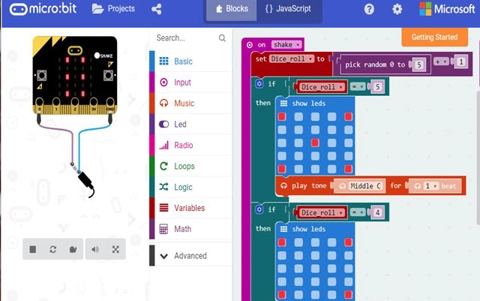BBC Micro:bit project

About this assessment task
Students a create a portfolio of evidence documenting the process undertaken to create a digital solution using the BBC micro:bit. The teacher assesses the student’s knowledge and skills using the student’s portfolio of evidence, self-reflection and think aloud.
Year band: 5-6
Achievement StandardAchievement Standard
The highlighted section indicates coverage of the relevant parts of the standard
By the end of Year 6 students develop and modify digital solutions, and define problems and evaluate solutions using user stories and design criteria. They process data and show how digital systems represent data. Students design algorithms involving complex branching and iteration and implement them as visual programs including variables. They securely access and use multiple digital systems and describe their components and how they interact to process and transmit data. Students select and use appropriate digital tools effectively to plan, create, locate and share content, and to collaborate, applying agreed conventions and behaviours. They identify their digital footprint and recognise its permanence.
Assessment
Description
This task can be used for formative assessment purposes or as a summative assessment to assess what students have learned as a result of programming a BBC micro:bit to create a digital solution. It would be expected that the task be undertaken over at least 3-5 one-hour sessions.
The task requires students to create a digital solution incorporating the use of the BBC micro:bit. This is an open-ended task allowing students to select a project that is within their skills and capabilities.
Prior to implementing their programming, students develop a design that shows an algorithm of the program. Students use a portfolio to document the process undertaken. The portfolio will include, a description of the project; a record of the steps taken on each day; challenges along the way and a reflection of the process. Students also complete a set of 'I can…' statements relating to particular programming skills.
At the completion of the project students record a ‘think aloud’ and complete a self-reflection task. (Limit the video recording to a maximum of 2 min).
Formative assessment
Prior to commencing the task, discuss the Self-reflection handout and associated rubric so students are aware of what is being assessed.
Prior to implementing the programming element of the task, use the portfolio to ascertain how students are progressing. Focus on the following aspects to promote a discussion:
Consider the design and algorithm.
Is it logical?
Does it show how users interact with it?
Does it include any decisions (branching)?
Are parts of the code repeated? If so, can loops be included within the program?
Are there parts of the program that are causing challenges? How might these challenges be overcome?
To overcome challenges students may require support from:
- a person with relevant skills in the class,
- YouTube tutorials or online BBC micro:bit help references,
- copying and remixing existing code from a similar project found online or in class or teacher directed.
Summative assessment
Collect four pieces of evidence for assessment.
- Design
- Students provide a document of their design created prior to implementing their digital solution.
- Portfolio
- Students provide their completed portfolio and use it to discuss the process (how they progressed on the project and how effectively they used their time).
- Self-reflection
- Students use the Self-reflection handout to evaluate their effort against the rubric supplied.
- Think aloud
- Students create and record a brief presentation ‘think aloud’ that explains how they designed and created their digital solution. Students may choose to use the Seesaw application or they may simply create a brief slide presentation incorporating photographs and text.
- Use the assessment checklist to record specific details of their design and programming skills and knowledge.
Assessment Checklist
This assessment checklist provides a guide to record the student’s demonstrated skills and knowledge.
Word and pdf versions of the checklist can be dowloaded in the resources section.
| Demonstrated knowledge/skills | Yes/No or progressing | Comments |
|---|---|---|
|
The student documented their design before implementing their digital solution. In their design the student includes:
The student portfolio is complete and includes
The student completed the self-reflection which provides:
|
||
|
The students create and record a brief presentation to explain their project and the process involved, including
|
||
|
The student can: |
||
|
The student would benefit to next work on: |
||
Resources
- BBC Micro:bit project assessment checklist (PDF version)
- BBC Micro:bit project assessment checklist (Word version)
- BBC Micro:bit project self-reflection (PDF version)
- BBC Micro:bit project self-reflection (Word version)
- Project log (PDF version)
- Project log (Word version)